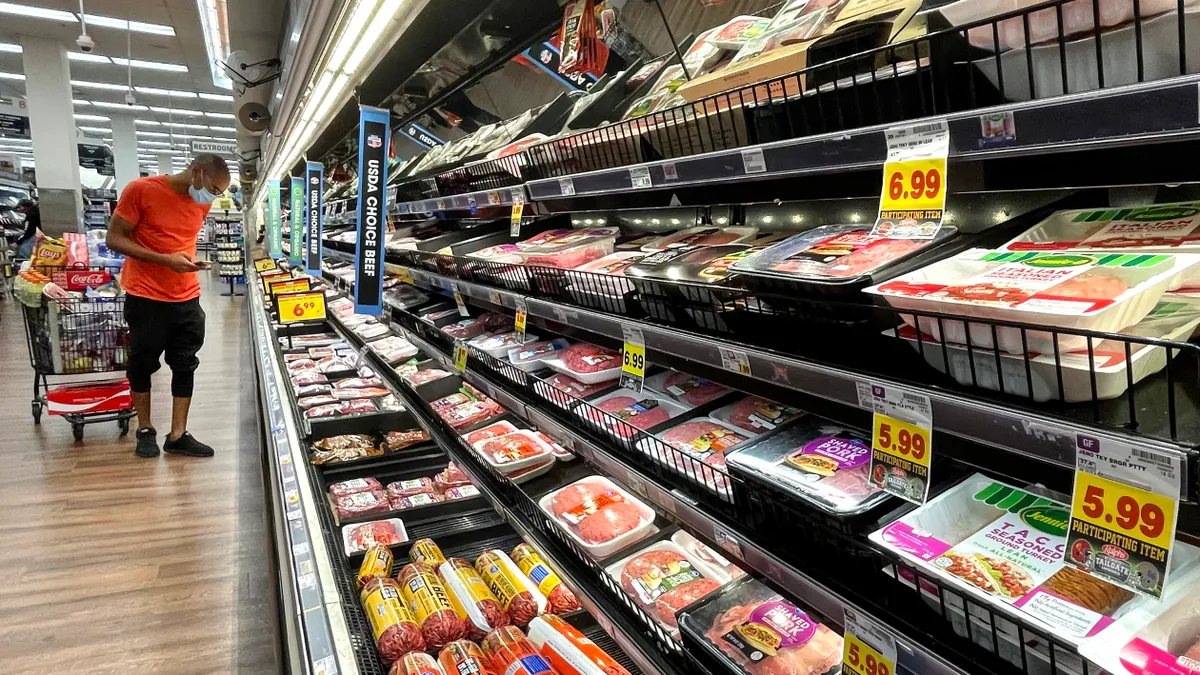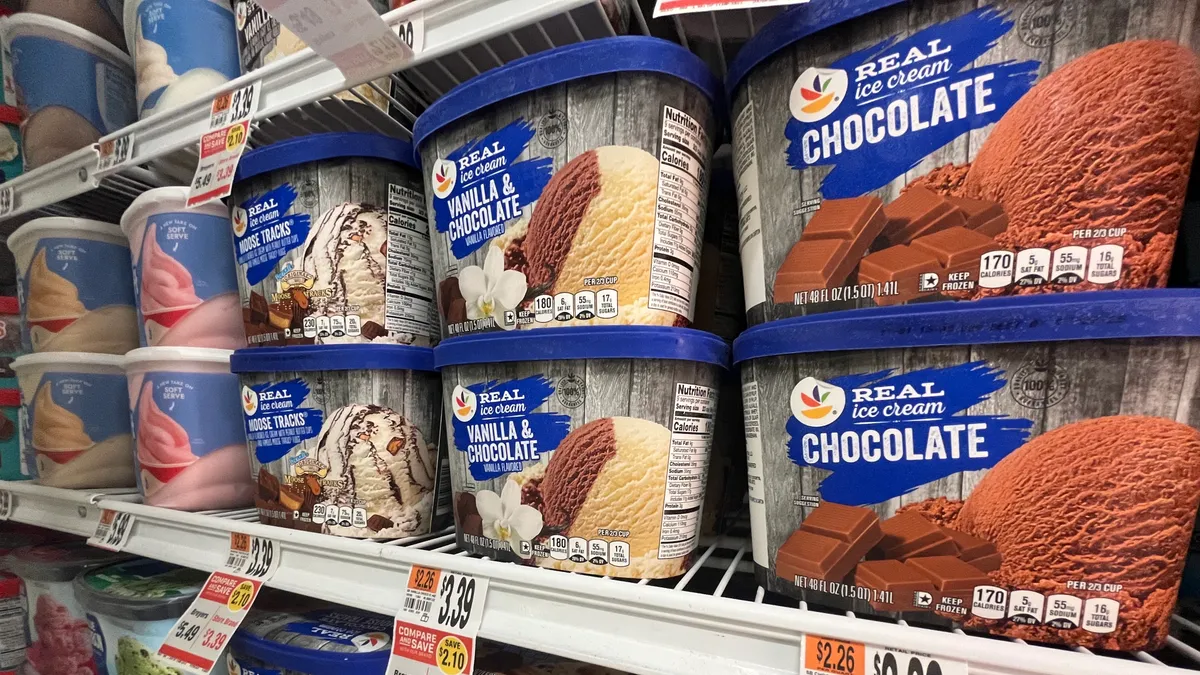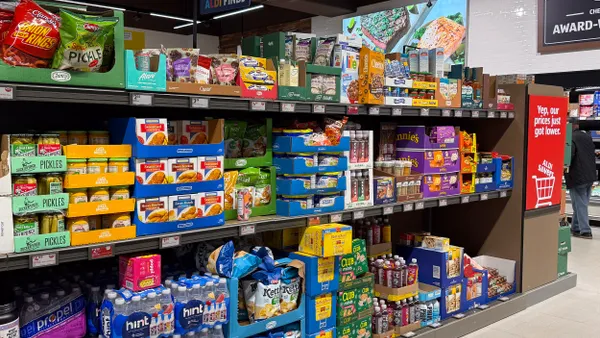Whether meat, produce, bread or dairy, there has not been a single food category that has escaped inflationary pressures. Most recently, the consumer price index for food-at-home recently saw its biggest 12-month increase in more than 40 years, according to U.S. Bureau of Labor Statistics data.
Supply chain disruptions, labor shortages and higher fuel and transportation costs have all fed into the increase. Extreme weather has as well, and it has led to shortages of major crops, from durum wheat to citrus. More recently, Russia's assault on Ukraine has devastated regional food supply chains, caused major CPG companies to halt operations and investments, and triggered price spikes for global commodities such as wheat and soybeans.
But despite this chaotic picture for food prices, Michael Swanson, chief agricultural economist at Wells Fargo, believes that many — but not all — of these issues will sort themselves out in the coming months. Swanson spoke to sister site Food Dive this past week to share his take on the current state of inflation, its main drivers, and "the biggest mistake" that food CPGs could make as they try to navigate the price volatility. What follows are highlights of that conversation.
Editor’s note: This interview has been edited for clarity and brevity.
FOOD DIVE: February’s Consumer Price Index data showed levels of inflation for different commodities, but that was before the Russia invasion really began to impact things. Going forward, is there a sense where price increases will be concentrated?
MICHAEL SWANSON: A couple of things come to mind that I think are a little bit different than what you would hear generally. One is when we look back at the current inflation, we're seeing food at home running at 8.7% year-over-year, which of course everybody knows is a multi-decade high for food inflation. That's not a result of a shortage of ingredients — it’s hard for a lot of people to really believe that. The price increases we're seeing today, those were negotiated back in November, December and January between the food manufacturers and the food retailers. What we're seeing there was the labor and the transportation and the packaging costs being passed along. So we really haven't had a food shortage or food scarcity. Food inflation to date has represented almost entirely that transformation process of turning what we already had abundantly into what we want to eat.
Do you see any compounding factors leading to higher prices for any specific commodities?
Absolutely: protein, which has led the way in the food inflation spike of 2020 during COVID and the current spike. Basically, when you talk about protein, you're talking about transforming corn and soybean meal and other basic feed grains and into animals. And when you see the price that we have for the feed range right now, for the people that have the livestock that have to buy that, they're obviously going to be catching a new wave of price inflation. And you're concentrating higher-price grain and multiplying it by that multiplier effect of the protein. So, yes, we would expect that meat, poultry and dairy to really compress their margins and also pass along at higher costs, because you can't run that sector without the higher price of corn and soybeans.
Prices for wheat hit their highest point in over a decade after Russia's invasion. With Russia and Ukraine responsible for 29% of wheat exports, do you have any insight into how that dynamic could be changing in the future?
Let's go back and talk about a couple things that the general public doesn't understand. First, the United States exports wheat, has and always will, so we’re not an importer. But that doesn't mean we're insulated from the world market. If a grain operation can export wheat at a higher price, they will do so and then the domestic market has to match it. And so the run up in wheat prices is almost entirely the fact that the rest of the world is going to be short due to the missing Ukraine and Russian wheat. Not us — we still grow way more wheat than we need.
Having said that, we produce a very high-quality wheat, the United States grain handling system. I used to work for Cargill. It's clean, it's high quality, it's sorted, well handled. So, it's highly prized by a lot of the wealthier countries around the world. So that definitely is going to push up the price of flour. Flour equals higher-price bread flour, higher-price flour equals higher-price chips and crackers, as well as pasta. So there's no way to hide from that global trade problem.
What about prices for other food commodities such as corn and soy, which have also trended upward?
Here are some numbers that I've been sharing with a lot of purchase managers, just to put things in context: Ukraine and Russia have 190 million people in two countries out of 8 billion [globally], so they have 2.4% of the population in the globe. They account for 3.6% of global agricultural production. So that means they have a surplus — that's why they're important in the export market. So it's pretty, pretty similar to their total but they're 14.6% of the global production of wheat — 11.3% is in Russia, 3.3% was in Ukraine. So that's why they are such an important part of the wheat market.
So Russia is part of the corn market — 3.8% of the global trade and production — but they certainly shouldn't be a price set. But we have this current flow through to our domestic price model, based on a relatively small piece of the market. Now [for] the wheat, they're a bigger piece of a small market.
One thing you hear with no context is that Ukraine does 80% of the world's trade in sunflower oil. Yes, but sunflower's like 3% of the total edible oil market. So they're a big player in a very small piece of that market. It's not like they're Malaysia with palm oil. They're nowhere near that type of influence there.
So once again, the market is panicked between the canola trade and that soybean trade. I'm not going to say you can stand against the market in the short term, but certainly, the numbers themselves don't justify the amount of volatility we've seen in the market, on a historical basis.
Do you see any of the major factors causing price increases right now abating in the coming months?
It's surprising but we now have more truck driving than we've ever had before. And we now have more people working in food manufacturing than we’ve ever had before. So they've been able to hire enough people. I was with several producers last week and I always ask, “What's your labor situation?” And they said that surprisingly, they’d always like to have a few more good people, but they're well past that dire situation a year or so ago where they were running short-staffed continuously. So what that says is if you are well-staffed and continuously staffing, the adequate wage pressures that start to slow, you're not going to have to keep bidding higher and higher. That doesn't mean you go backwards, but I see some good things happening.
We're seeing a recovery in the manufacturing floor and in the trucking industry, which really is going to help take away some of those major constraints that are really pushed up on food inflation. Now we're going to be dealing with higher ingredient costs, kind of the second wave here, but we will be dealing with both of them at the same time.
So could improving labor issues offset the impacts of ingredient shortages?
Absolutely — and things that don't repeat themselves. For example, last year we had that freeze in Texas that impacted the packaging availability, the petrochemical complex. It doesn’t look like we’re going to have that again this year. I heard that some of the container traffic delays are down. Container prices are still high, but those can drop dramatically. As we unkink a lot of these supply chain issues ... that's going to be really helpful because that was the genesis of the first wave of inflation. If it doesn't continue, then they'll be able to absorb the ingredient cost a lot better.






















